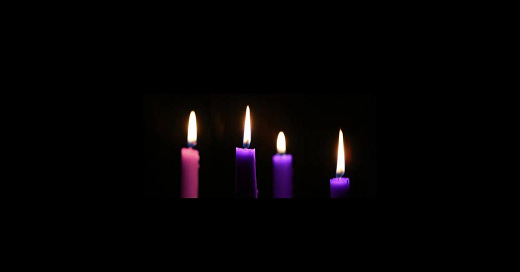As I mentioned in my column last week, every year, there is a debate held online as to whether Advent is a penitential season or not. Modern liturgists (you can leave out the “liturg”) will tell you it’s not. When I was in seminary, my liturgy professor argued that there should actually be two different liturgical shades of purple, one with a bluish hue for Advent, a more “royal purple” since we’re awaiting the coming of the King, and one with a reddish hue for Lent, a more “penitential purple” for the properly penitential season. In fact, the Canadian Ordo (the book that tells the priest what Mass texts to use for a given day) lists “violet” as the colour of Advent and “purple” as the colour of Lent.
As an aside, that same liturgy professor also argued that we should have two shades of red vestments as well, a purplish “bloody” red for the feasts of martyrs and a more orange “fiery” shade for feasts of the Holy Ghost, but I digress.
Despite what a liturgist might tell you, the Church only recognizes one shade of purple vestments (actually violet vestments) for both Advent and Lent. This colour is universally recognized as the penitential liturgical colour, hence its use for Confession, as well as any blessing that involves an exorcism. So that should tell us something right away, if we are using a penitential colour, then we must be in a penitential season, but let’s delve further.
During Lent, the Gloria is not sung or said at any Mass of the Season; the same goes for Advent. During Lent, the Alleluia is suppressed, its joyful sound only returning at Easter. During Advent, the Alleluia is not suppressed entirely since we still acknowledge the joy of Christ’s first coming as we await the second; however, on weekdays of Advent, the Alleluia is not said at Mass, another hint of penance.
Another liturgical change during the Advent season is not as apparent for most Catholics but is worth noting nonetheless. In the pre-Vatican II Divine Office, the office of Lauds, which is said at the beginning of each day, comes in two versions, or flavours, if you will. On most days, the first set of psalms is used, psalms of praise for the start of the day, however on penitential days, such as vigils, Embertides, and the Season of Lent, the second set of psalms is used, psalms with a distinctly penitential character. Now, I’ll let you guess which set of psalms is used during Advent.
So yes, despite what you might hear, for traditional Catholics, Advent is, without a doubt, a penitential season. Now, that being said, unlike Lent, Catholics are not obliged to perform penance during Advent; that was the case even before Vatican II. Mandatory penance during Advent has not been practiced in the Western Church for a very long time, though our Eastern brothers and sister continue the tradition. But just because the Church does not oblige us to penance at this time does not mean that we should feast our way through Advent.
Most of the Advent season is a preparation for the Second Coming of Christ, something that should inspire us to make atonement for our sins, and after all, voluntary penance is far more meritorious than an imposed penance. If you haven’t been doing anything penitential yet this Advent season, there are still three more weeks to go so that we can approach the Christmas feast with hearts truly renewed.
As an addendum, don’t forget to signup for our new weekly newsletter as well; it includes the weekly Mass schedule, coming events, and more content for your reflection:



